Recent
Publications >>>
-

|
-
- Metric-Aware
Processing of Spherical Imagery
-
- M. Kazhdan and H.
Hoppe
- SIGGRAPH Asia
(2010)
Abstract: Processing
spherical images is challenging. Because no spherical parameterization
is globally uniform, an accurate solver must account for the spatially
varying metric. We present the first efficient metric-aware solver for
Laplacian processing of spherical data. Our approach builds on the
commonly used equirectangular parameterization, which provides
differentiability, axial symmetry, and grid sampling. Crucially, axial
symmetry lets us discretize the Laplacian operator just once per grid
row. One difficulty is that anisotropy near the poles leads to a poorly
conditioned system. Our solution is to construct an adapted hierarchy
of finite elements, adjusted at the poles to maintain derivative
continuity, and selectively coarsened to bound element anisotropy. The
resulting elements are nested both within and across resolution levels.
A streaming multigrid solver over this hierarchy achieves excellent
convergence rate and scales to huge images. We demonstrate applications
in reaction-diffusion texture synthesis and panorama stitching and
sharpening.
-
|
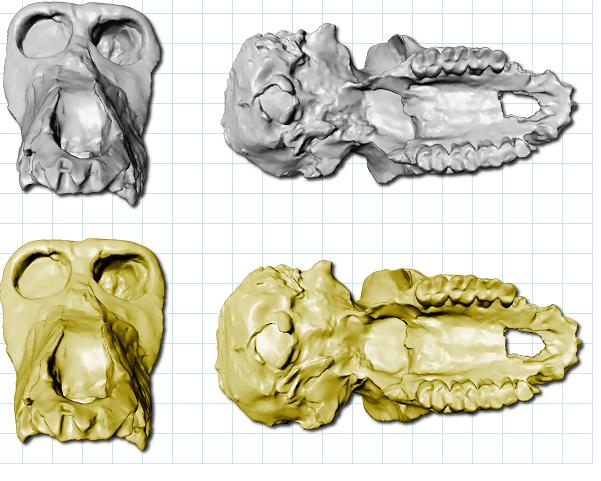
|
-
- Closed-form
Blending of Local Symmetries
-
- D. Ghosh, N.
Amenta, and M. Kazhdan
- Eurographics/ACM
SIGGRAPH Symposium
on Geometry Processing (July 2010)
Abstract: We present a
closed-form solution for the symmetrization problem, solving for the
optimal deformation that reconciles a set of local bilateral
symmetries. Given as input a set of point-pairs which should be
symmetric, we first compute for each local neighborhood a
transformation which would produce an approximate bilateral symmetry.
We then solve for a single global symmetry which includes all of these
local symmetries, while minimizing the deformation within each local
neighborhood. Our main motivation is the symmetrization of digitized
fossils, which are often deformed by a combination of compression and
bending. In addition, we use the technique to symmetrize articulated
models.
-
|

|
-
- A
User-Assisted Approach to Visualizing Multidimensional Images
-
- J. Lawrence, S.
Arietta, M. Kazhdan, D. Lepage, and C. O'Hagan
- IEEE
Transactions on Visualizations and Computer Graphics (TVCG) (2010)
Abstract:
We present a new technique for fusing together an arbitrary number of
aligned images into a single color or intensity
image. We approach this fusion problem from the context of
Multidimensional Scaling (MDS) and describe an algorithm that preserves
the relative distances between pairs of pixel values in the input
(vectors of measurements) as perceived differences
in a color image. The two main advantages of our approach over existing
techniques are that it can incorporate user constraints
into the mapping process and it allows adaptively compressing or
exaggerating features in the input in order to make better use
of the output’s limited dynamic range. We demonstrate these
benefits by showing applications in various scientific domains and
comparing our algorithm to previously proposed techniques.
-
|
 |
-
- A
Statistical Approach for Achievable Dose Querying in IMRT Planning
-
- P. Simari, B. Wu,
R. Jacques, A. King, T. McNutt, R. Taylor, and M. Kazhdan
- Medical Image
Computing and Computer Assisted Intervention (MICCAI) (September
2010)
Abstract:
The task of IMRT planning, particularly in head-and-neck cancer, is a
difficult one, often requiring days of work from a trained dosimetrist.
One of the main challenges is the prescription of achievable target
doses that will be used to optimize a treatment plan. This work
explores a data-driven approach in which effort spent on past plans is
used to assist in the planning of new patients. Using a database of
treated patients, we identify the features of patient geometry that are
correlated with received dose and use these to prescribe target dose
levels for new patients. We incorporate our approach in a
quality-control system, identifying patients with organs that received
a dose significantly higher than the one recommended by our method. For
all these patients, we have found that a replan using our predicted
dose results in noticeable sparing of the organ without compromising
dose to other treatment volumes.
-
|

|
-
- Organization
of Data in Non-Convex Spatial Domains
-
- E. Perlman, R.
Burns, M. Kazhdan, R. Murphy, W. Ball, and N. Amenta
- Scientific and
Statistical Database Management Conference (SSDBM) (2010)
Abstract: We present a
technique for organizing data in spatial databases with non-convex
domains based on an automatic characterization using the medial-axis
transform (MAT). We define a tree based on the MAT and enumerate its
branches to partition space and define a linear order on the
partitions. This ordering clusters data in a manner that respects the
complex shape of the domain. The ordering has the property that all
data down any branch of the medial axis, regardless of the geometry of
the sub-region, are contiguous on disk. Using this data organization
technique, we build a system to provide efficient data discovery and
analysis of the observational and model data sets of the Chesapeake Bay
Environmental Observatory (CBEO). On typical CBEO workloads in which
scientists query contiguous substructures of the Chesapeake Bay, we
improve query processing performance by a factor of two when compared
with orderings derived from space filling curves.
-
|
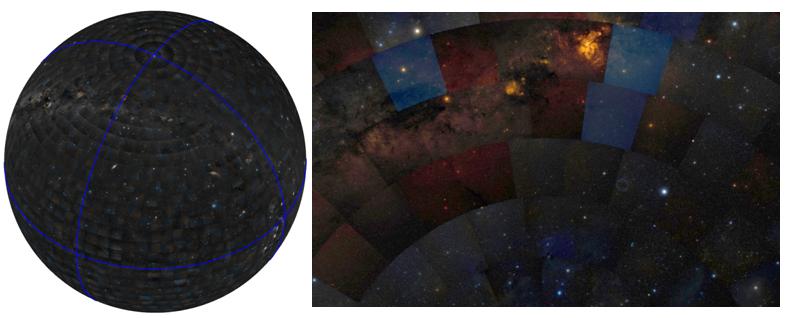 |
-
- Distributed
Gradient-Domain Processing of Planar and Spherical Images
-
- M.
Kazhdan, D. Surendran, and H. Hoppe
- ACM
SIGGRAPH Transactions
on Graphics (2010)
Abstract:
Gradient-domain
processing is widely used to edit and combine images. In this paper we
extend the framework in two directions. First, we adapt the
gradient-domain approach to operate on a spherical domain, to enable
operations such as seamless stitching, dynamic-range compression, and
gradient-based sharpening over spherical imagery. An efficient
streaming computation is obtained using a new spherical
parameterization with bounded distortion and localized boundary
constraints. Second, we design a distributed solver to efficiently
process large planar or spherical images. The solver partitions images
into bands, streams through these bands in parallel within a networked
cluster, and schedules computation to hide the necessary
synchronization latency. We demonstrate our contributions on several
datasets including the Digitized Sky Survey, a terapixel spherical scan
of the night sky.
-
-
|
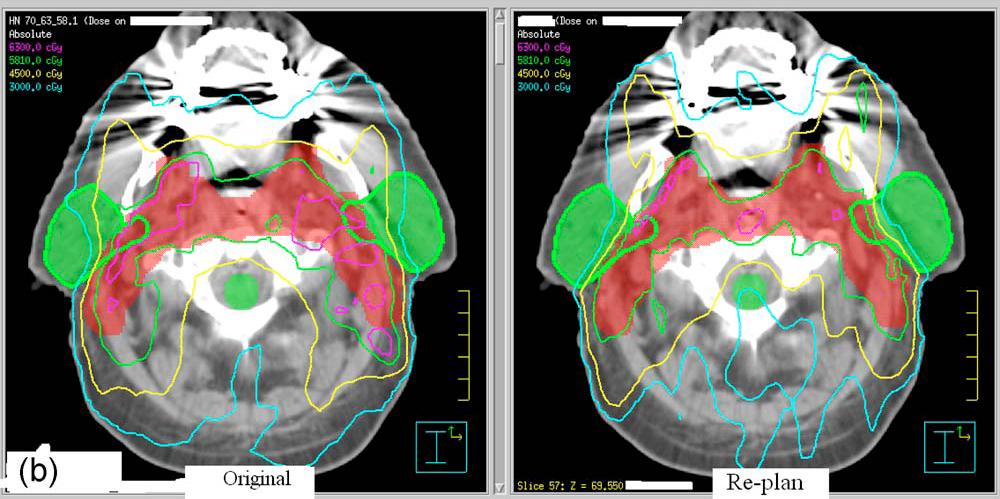 |
- Patient
Geometry-Driven Information Retrieval for IMRT Treatment Plan
Quality Control
- B.
Wu, F. Ricchetti, G. Sanguineti, M.
Kazhdan, P. Simari, M. Chuang, R. Taylor, R. Jacques, and T. McNutt
- Medical
Physics (December
2009,
Vol. 36, No. 12), pages 5497--5505
Abstract:
Intensity modulated radiation therapy IMRT treatment plan quality
depends on the planner’s level of experience and the amount
of
time the planner invests in developing the plan. Planners often
unwittingly accept plans when further sparing of the organs at risk
OARs is possible. The authors propose a method of IMRT treatment plan
quality control that helps planners to evaluate the doses of the OARs
upon completion of a new plan.
|
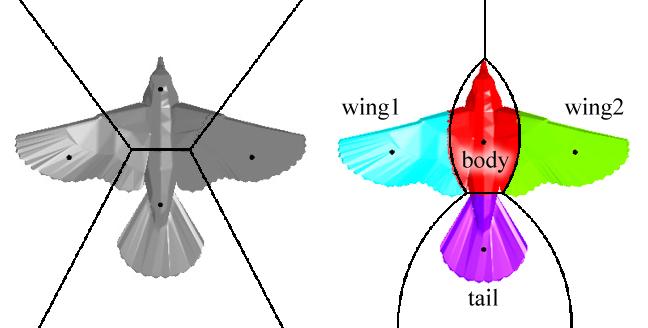 |
-
- Multi-objective
Shape Segmentation and Labeling
- P.
Simari, D. Nowrouzezahrai, E.
Kalogerakis, K. Singh
- Eurographics/ACM
SIGGRAPH Symposium
on Geometry Processing
(July
2009), pages 1415--1425
Abstract:
Shape segmentations designed for different applications show
significant variation in the composition of their parts. In this paper,
we introduce the segmentation and labeling of shape based on the
simultaneous optimization of multiple heterogenous objectives that
capture application-specific segmentation criteria. We present a number
of efficient objective functions that capture useful shape adjectives
(compact, flat, narrow, perpendicular, etc.) Segmentation descriptions
within our framework combine multiple such objective functions with
optional labels to define each part. The optimization problem is
simplified by proposing weighted Voronoi partitioning as a compact and
continuous parametrization of spatially embedded shape segmentations.
Separation of spatially close but geodesically distant parts is made
possible using multi-dimensional scaling prior to Voronoi partitioning.
Optimization begins with an initial segmentation found using the
centroids of a k-means clustering of surface elements. This partition
is automatically labeled to optimize heterogeneous part objectives and
the Voronoi centers and their weights optimized using Generalized
Pattern Search. We illustrate our framework using several diverse
segmentation applications: consistent segmentations with semantic
labels, bounding volume hierarchies for path tracing, and automatic rig
and clothing transfer between animation characters.
-
|
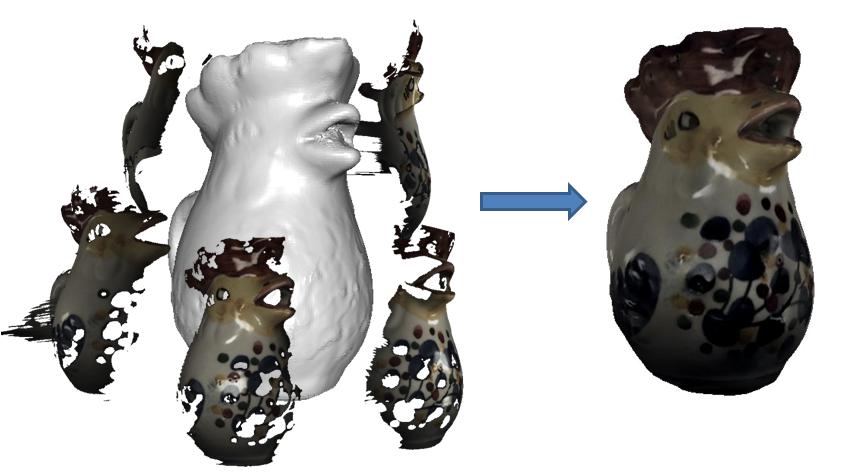 |
- Estimating
the Laplace-Beltrami Operator by Restricting 3D Functions
(Slides,
Source
and
Executables)
- M.
Chuang, L. Luo, B. Brown, S.
Rusinkiewicz, and
M. Kazhdan
- Eurographics/ACM
SIGGRAPH Symposium
on Geometry Processing
(July
2009), pages 1475--1484
Abstract:
We present a novel approach for computing and solving the Poisson
equation over the surface of a mesh. As in previous approaches, we
define the Laplace-Beltrami operator by considering the derivatives of
functions defined on the mesh. However, in this work, we explore a
choice of functions that is decoupled from the tessellation.
Specifically, we use basis functions (second-order tensor-product
B-splines) defined over 3D space, and then restrict them to the
surface. We show that in addition to being invariant to mesh topology,
this definition of the Laplace-Beltrami operator allows a natural
multiresolution structure on the function space that is independent of
the mesh structure, enabling the use of a simple multigrid
implementation for solving the Poisson equation.
|
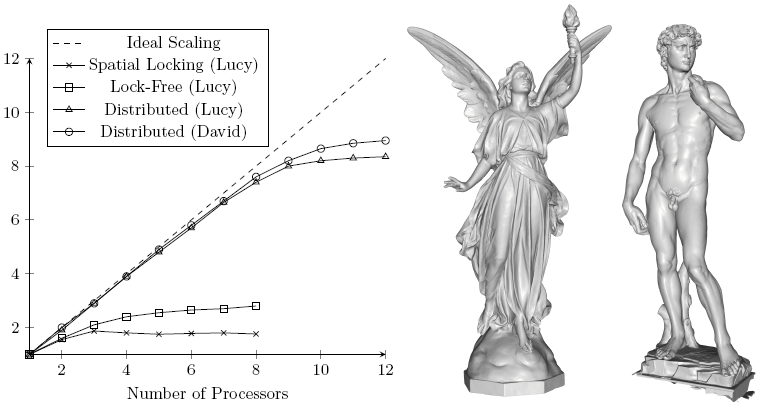
|
- Parallel
Poisson Surface Reconstruction
- M.
Bolitho, M. Kazhdan, R. Burns, and H.
Hoppe
- Inernational
Symposium on Visual
Computing (November
2009)
Abstract:
In this work we describe a parallel implementation of the Poisson
Surface Reconstruction algorithm based on multigrid
domain decomposition. We compare implementations using different models
of data-sharing between processors and show that a parallel
implementation with distributed memory provides the best scalability.
Using our method, we are able to parallelize the reconstruction of
models from one billion data points on twelve processors across three
machines, providing a ninefold speedup in running time without
sacrificing reconstruction accuracy.
|
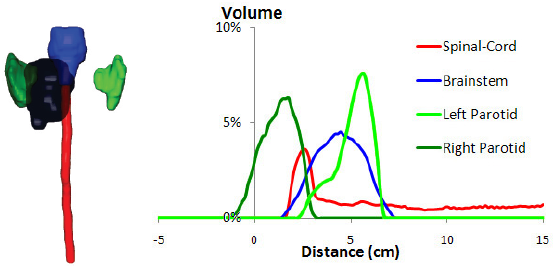
|
-
- A
Shape
Relationship Descriptor for Radiation Therapy Planning
- M.
Kazhdan, P. Simari, T. McNutt, B. Wu,
R. Jaques,
M. Chuang, and R. Taylor
- Medical
Image Computing and Computer
Assisted
Intervention (MICCAI, September
2009)
- Abstract:
In this paper we address the challenge of matching patient geometry to
facilitate the design of patient treatment plans in radiotherapy. To
this end we propose a novel shape descriptor, the Overlap Volume
Histogram, which provides a rotation and translation invariant
representation of a patient’s organs at risk relative to the
tumor volume. Using our descriptor, it is possible to accurately
identify database patients with similar constellations of organ and
tumor geometries, enabling the transfer of treatment plans between
patients with similar geometries. We demonstrate the utility of our
method for such tasks by outperforming state of the art shape
descriptors in the retrieval of patients with similar treatment plans.
We also preliminarily show its potential as a quality control tool by
demonstrating how it is used to identify an organ at risk whose dose
can be significantly reduced.
-
|
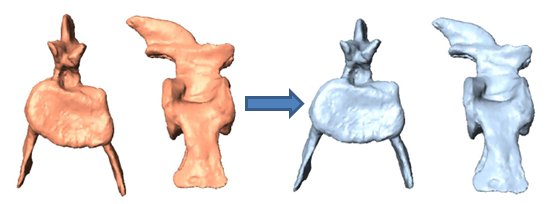
|
-
- Symmetry
Restoration by Stretching
- M.
Kazhdan, N. Amenta, S. Gu, D. Wiley,
and B.
Hamann
- Canadian
Conference on Computational
Geometry
(August 2009)
- Abstract:
We consider restoring the bilateral symmetry of an object which has
been deformed by compression. This problem arises in paleontology,
where symmetric bones are compressed in the process of fossilization.
Our input is a user-selected set P of point-pairs on the deformed
object, which are assumed to be mirror-images in some undeformed set
AP, with some added noise. We carefully formulate the problem, and give
a closed-form solution.
-
|

|
-
- Streaming
Multigrid for Gradient-Domain Operations on Large Images
- (Slides, Supplemental
Images, St
James, Source
and Executables)
- M.
Kazhdan and H. Hoppe
- SIGGRAPH
(August 2008)
- Abstract:
We introduce a new tool to solve the large linear systems arising from
gradient-domain image processing. Specifically, we develop a streaming
multigrid solver, which needs just two sequential passes over
out-of-core data. This fast solution is enabled by a combination of
three techniques: (1) use of second-order finite elements (rather than
traditional finite differences) to reach sufficient accuracy in a
single V-cycle, (2) temporally blocked relaxation, and (3) multi-level
streaming to pipeline the restriction and prolongation phases into
single streaming passes. A key contribution is the extension of the
B-spline finite-element method to be compatible with the
forward-difference gradient representation commonly used with images.
Our streaming solver is also efficient for inmemory images, due to its
fast convergence and excellent cache behavior. Remarkably, it can
outperform spatially adaptive solvers that exploit application-specific
knowledge. We demonstrate seamless stitching and tone-mapping of
gigapixel images in about an hour on a notebook PC.
-
|
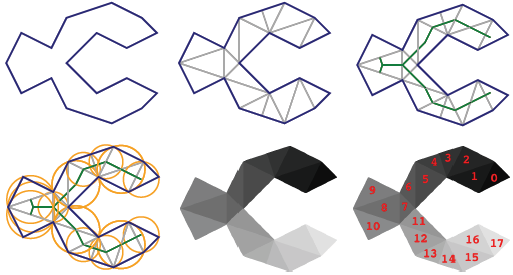
|
-
- Organizing
and Indexing Non-Convex Regions
- E.
Perlman, R. Burns, and M. Kazhdan
- Demonstration
Paper International
Conference on
Very Large Data Bases (VLDB) (2008),
pages 1500--1503
- Abstract:
We demonstrate data indexing and query processing techniques that
improve the efficiency of comparing, correlating, and joining data
contained in non-convex regions. We use computational geometry
techniques to automatically characterize the region of space from which
data are drawn, partition the region based on that characterization,
and create an index from the partitions. Our motivating application
performs distributed data analysis queries among federated database
sites that store scientific data sets from the Chesapeake Bay. Our
preliminary findings indicate that these techniques often reduce the
number of I/Os needed to serve a query by a factor of five -- depending
on the geometry of the query region.
-
|
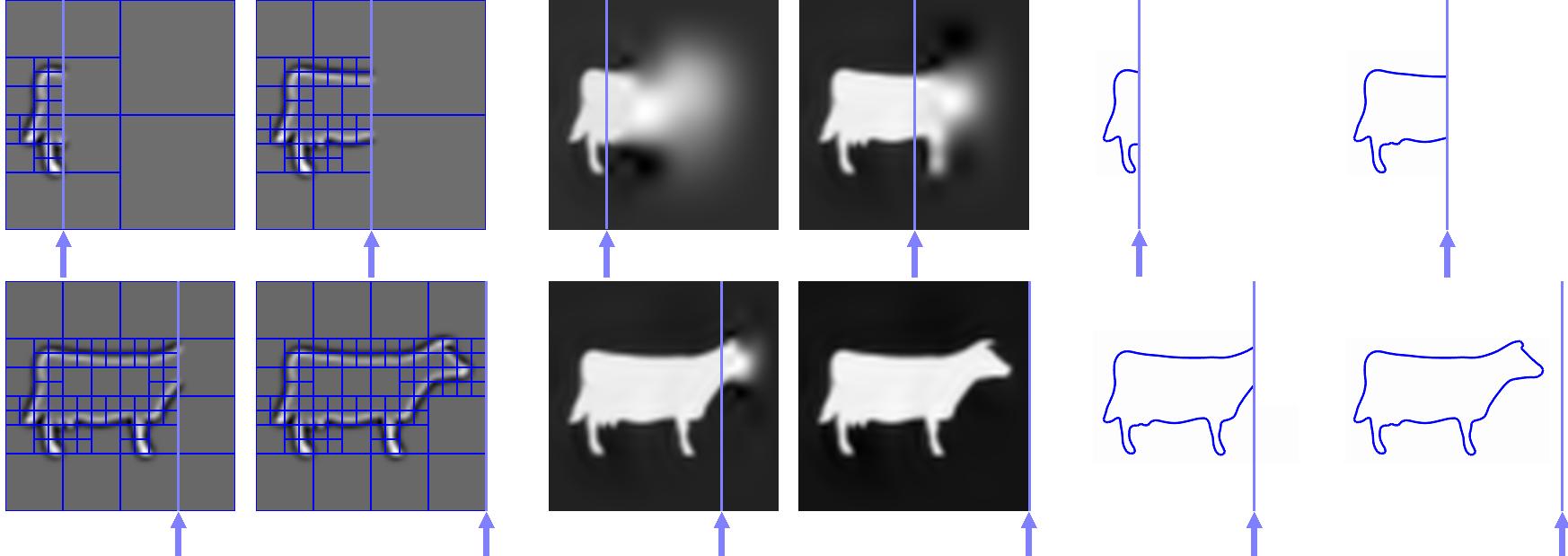
|
- M.
Bolitho, M. Kazhdan, R. Burns, and H.
Hoppe
- Eurographics/ACM
SIGGRAPH Symposium
on Geometry Processing (July
2007), pages 69--78
- Abstract:
Reconstruction of surfaces from huge collections of scanned points
often requires out-of-core techniques, and most such techniques involve
local computations that are not resilient to data errors. We show that
a Poisson-based reconstruction scheme, which considers all points in a
global analysis, can be performed efficiently in limited memory using a
streaming framework. Specifically, we introduce a multilevel streaming
representation, which enables efficient traversal of a sparse octree by
concurrently advancing through multiple streams, one per octree level.
Remarkably, for our reconstruction application, a sufficiently accurate
solution to the global linear system is obtained using a single
iteration of cascadic multigrid, which can be evaluated within a single
multi-stream pass. We demonstrate scalable performance on several large
datasets.
-
|
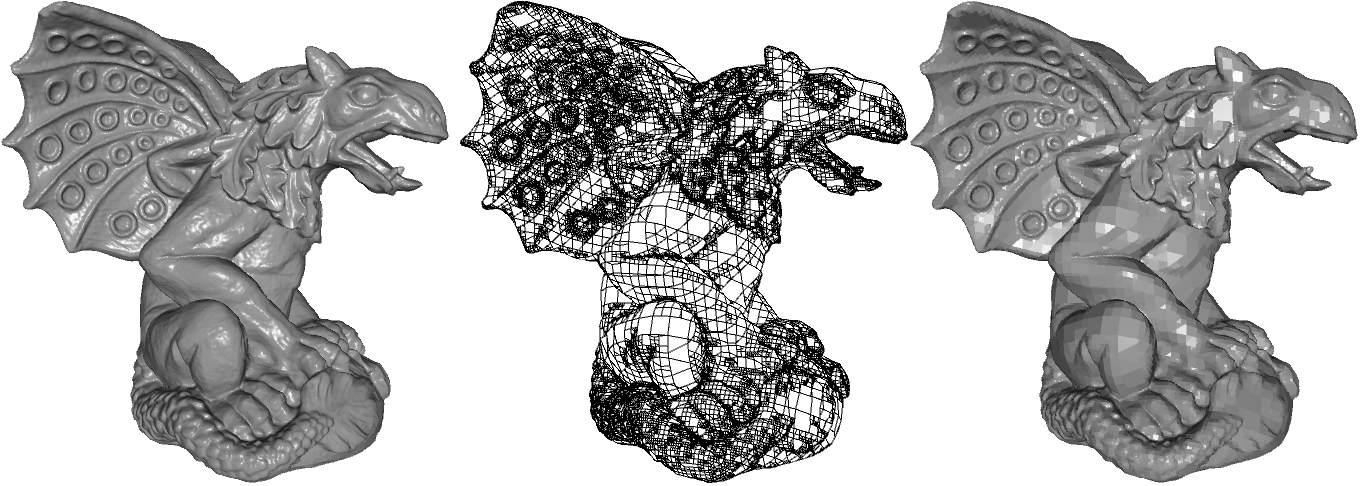
|
-
- Unconstrained
Isosurface Extraction on Arbitrary Octrees
(Slides,
Source
and
Executables)
- M.
Kazhdan, A. Klein, K. Dalal, and H. Hoppe
- Eurographics/ACM
SIGGRAPH Symposium
on Geometry Processing (July
2007), pages 125--133
- Abstract:
This paper presents a novel algorithm for generating a watertight
level-set from an octree. We show that the level- set can be
efficiently extracted regardless of the topology of the octree or the
values assigned to the vertices. The key idea behind our approach is
the definition of a set of binary edge-trees derived from the
octree’s topology. We show that the edge-trees can be used
define the positions of the isovalue-crossings in a consistent fashion
and to resolve inconsistencies that may arise when a single edge has
multiple isovalue-crossings. Using the edge-trees, we show that a
provably watertight mesh can be extracted from the octree without
necessitating the refinement of nodes or modification of their values.
-
|

|
-
- An
Approximate and Efficient Method for Optimal Rotation Alignment of 3D
Models
- M.
Kazhdan
- IEEE
Transactions on Pattern Analysis
and
Machine Intelligence (July
2007, Vol. 29, No. 7), page
1221--1229
- Abstract:
In many shape analysis applications, the ability to find the best
rotation that aligns two models is an essential first step in the
analysis process. In the past, methods for model alignment have either
used normalization techniques, such as PCA alignment, or have performed
an exhaustive search over the space of rotation to find the best
optimal alignment. While normalization techniques have the advantage of
efficiency, providing a quick method for registering two shapes, they
are often imprecise and can give rise to poor alignments. Conversely,
exhaustive search is guaranteed to provide the correct answer, but even
using efficient signal processing techniques, this type of
approach can be prohibitively slow.
- In
this paper we present a new method
for aligning two 3D shapes. We show that the method is markedly faster
than existing approaches based on efficient signal processing and we
provide registration results demonstrating that the alignments obtained
using our method have a high degree of precision and are markedly
better then those obtained using normalization.
-
|
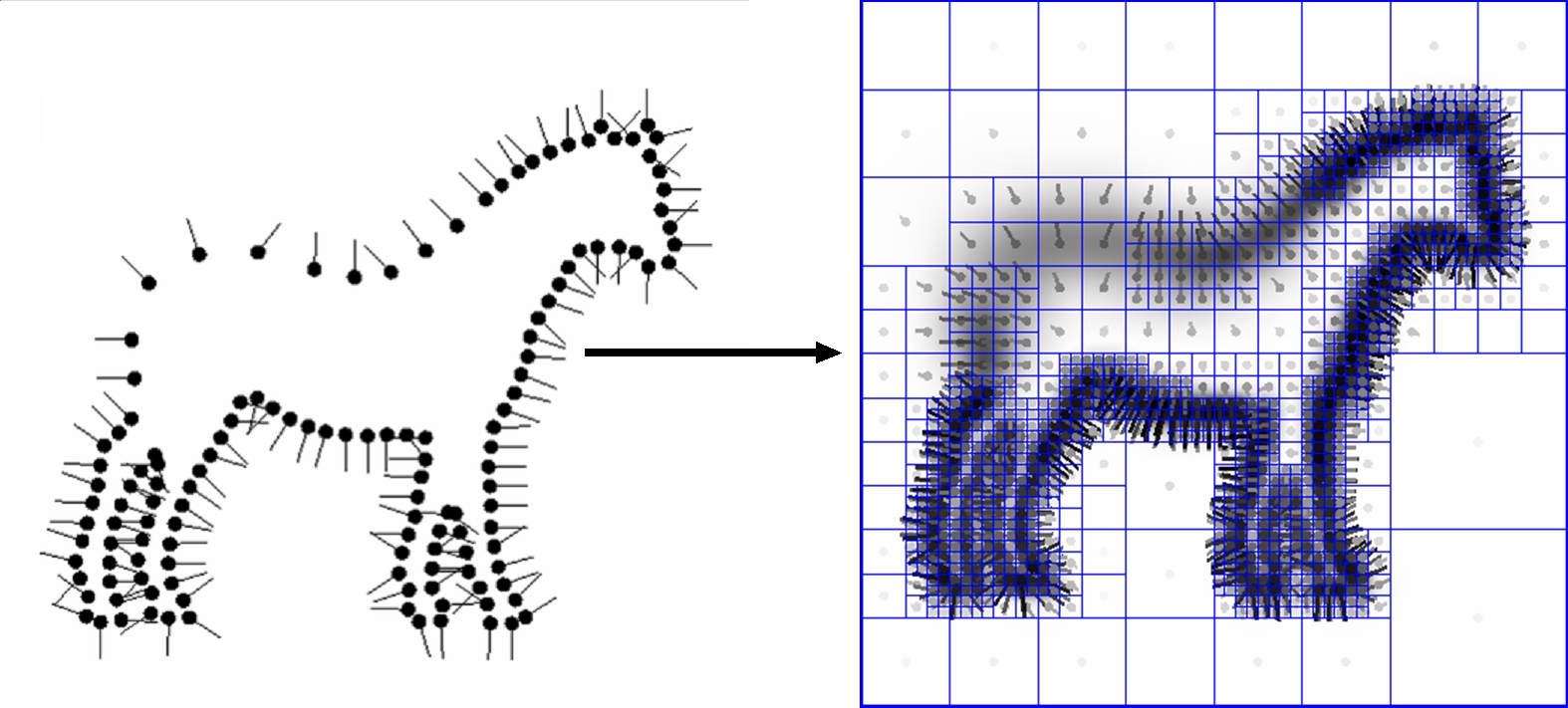 |
-
- Poisson
Surface Reconstruction
(Slides,
Source
and Executables)
- M.
Kazhdan, M. Bolitho, and H. Hoppe
- Eurographics/ACM
SIGGRAPH Symposium
on Geometry Processing (June
2006), pages 61--70
- Abstract:
We show that surface reconstruction from oriented points can be cast as
a spatial Poisson problem. This Poisson formulation considers all the
points at once, without resorting to heuristic spatial partitioning or
blending, and is therefore highly resilient to data noise. Unlike
radial basis function schemes, our Poisson approach allows a hierarchy
of locally supported basis functions, and therefore the solution
reduces to a well conditioned sparse linear system. We describe a
spatially adaptive multiscale algorithm whose time and space
complexities are proportional to the size of the reconstructed model.
Experimenting with publicly available scan data, we demonstrate
reconstruction of surfaces with greater detail than previously
achievable.
-
|
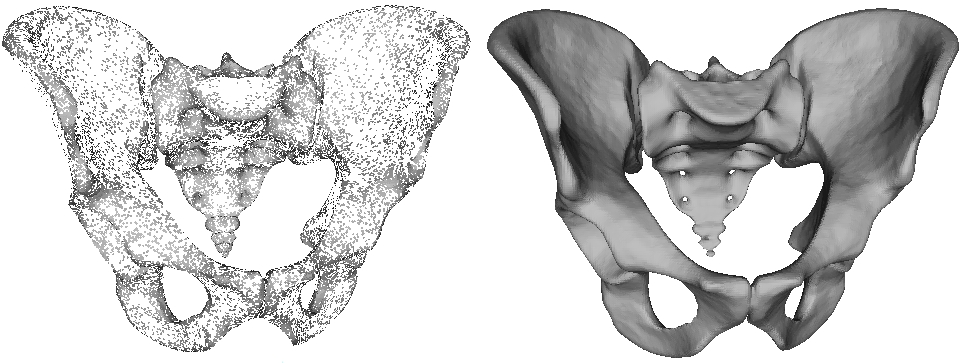 |
-
- Reconstruction
of Solid Models from Oriented Point Sets
(Slides,
Source
and Executables
)
- M.
Kazhdan
- Eurographics/ACM
SIGGRAPH Symposium
on Geometry Processing (July
2005), pages 73--82
- Abstract:
In this paper we present a novel approach to the surface reconstruction
problem that takes as its input an oriented point set and returns a
solid, water-tight model. The idea of our approach is to use Stokes'
Theorem to compute the characteristic function of the solid model (the
function that is equal to one inside the model and zero outside of it).
Specifically, we provide an efficient method for computing the Fourier
coefficients of the characteristic function using only the surface
samples and normals, we compute the inverse Fourier transform to get
back the characteristic function, and we use iso-surfacing techniques
to extract the boundary of the solid model.
The advantage of our approach is that it provides an automatic, simple,
and efficient method for computing the solid model represented by a
point set without requiring the establishment of adjacency relations
between samples or iteratively solving large systems of linear
equations. Furthermore, our approach can be directly applied to models
with holes and cracks, providing a method for hole-filling and
zippering
of disconnected polygonal models.
-
|
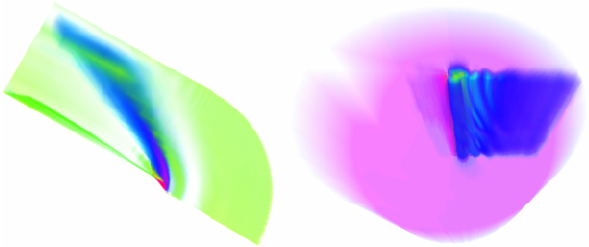 |
-
- Visualization
of Time-Varying Curvilinear Grids Using a 3D Warp Texture
- Y.
Chen, J. D. Cohen, and Subodh Kumar
- Proceedings
of Vision, Modeling, and
Visualization 2005 (10th International Fall Workshop). 9 pages
- Abstract:
We present a
novel scheme to interactively visualize time-varying
scalar fields defined on a curvilinear grid. We create a 3D warp
texture
that maps points inR3 into the grid coordinate system. At rendering
time, the warping function is reconstructed at each fragment using
tri-linear interpolation, and provides the 3D texture coordinates
required to look up a scalar field value stored in a separate scalar
texture. In essence, this approach reduces the problem of rendering a
curvilinear grid to the problem of rendering a regular grid with one
additional texture lookup.
- Because
the curvilinear grid data typically lies on a regular grid in
its native space, the scalar data is easily stored in a 3D texture
without the need for explicit resampling. For many time-varying data
sets, the warping function itself is constant over time, so only the 3D
scalar texture needs to be reloaded with each time step. Thus this
factorization of the problem minimizes the bandwidth requirements for
time-varying
playback. We demonstrate the approach on several data sets, achieving
interactive performance with low approximation error.
-
|
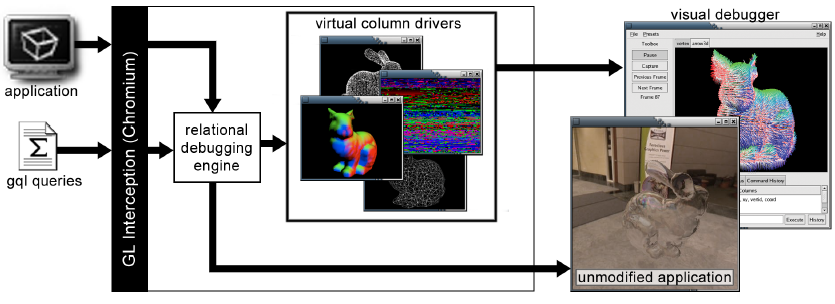 |
-
- A Relational
Debugging Engine for Graphics Pipeline
- N.
Duca, K. Niski, J. Bilodeau, M.
Bolitho, Y. Chen, and J. D. Cohen
- ACM
Transactions on Graphics
(Proceedings of SIGGRAPH 2005). 24 (3). 11 pages
- Abstract: We
present a
new, unified approach to debugging graphics software. We propose a
representation of all graphics state over the course of program
execution as a relational database, and produce a query-based framework
for extracting, manipulating, and visualizing data from all stages of
the graphics pipeline. Using an SQLbased query language, the programmer
can establish functional relationships among all the data, linking
OpenGL state to primitives to vertices to fragments to pixels. Based on
the Chromium library, our approach requires no modification to or
recompilation of the program to be debugged, and forms a superset of
many existing techniques for debugging graphics software. [ video
]
-
|
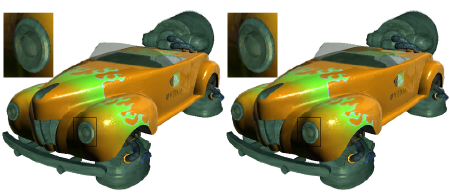
|
-
- Hardware-Compatible
Vertex Compression Using Quantization and Simplification
- B.
Purnomo, J. Bilodeau, J. D. Cohen, and
S. Kumar
- Proceedings
of ACM
SIGGRAPH/Eurographics Symposium on Graphics Hardware 2005. 10 pages
- Abstract: We
present a vertex compression technique suitable for efficient
decompression on graphics hardware. Given a user-specified number of
bits per vertex, we automatically allocate bits to vertex attributes
for quantization to maximize quality, guided by an image-space error
metric. This allocation accounts for the constraints of graphics
hardware by packing the quantized attributes into bins associated with
the hardware's vectorized vertex data elements. We show that this
general approach is also applicable if the user specifies a total
desired model size. We present an algorithm that integrally combines
vertex decimation and attribute quantization to produce the best
quality model for a user-specified data size. Such models have an
appropriate balance between the number of vertices and the number of
bits per vertex. Vertex data is transmitted to and optionally stored in
video memory in the compressed form. The vertices are decompressed
on-the-fly using a vertex program at rendering time. Our algorithms
not
only work well within the constraints of current graphics hardware but
also generalize to a setting where these constraints are relaxed. They
apply to models with a wide variety of vertex attributes, providing new
tools for optimizing space and bandwidthconstraints of interactive
graphics applications.
-
|
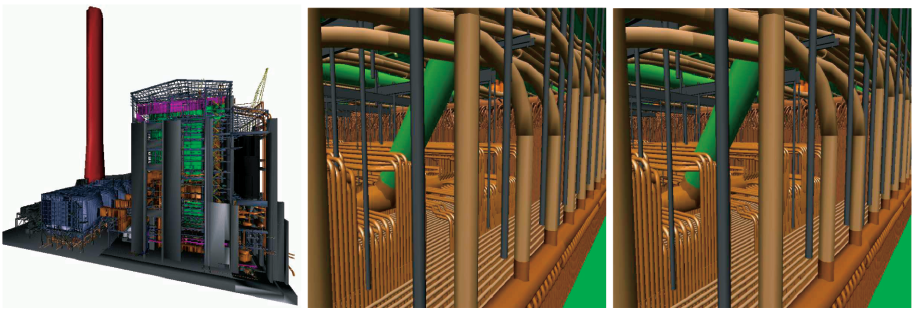 |
-
- vLOD:
High-Fidelity Walkthroughs of Large Virtual Environments
- J.
Chhugani, B. Purnomo, S. Krishnan, J.
D. Cohen, S. Venkatasubramanian, D. Johnson, and S. Kumar
- IEEE
Transactions on Visualization and
Computer Graphics, VOL. 11, NO. 1,
2005
- Abstract:
We present
visibility computation and data organization algorithms that enable
high-fidelity walkthroughs of large 3D geometric data sets. A novel
feature of our walkthrough system is that it performs work proportional
only to the required detail in visible geometry at the rendering time.
To accomplish this, we use a precomputation phase that efficiently
generates per cell vLOD: the geometry visible from a view-region at the
right level of detail. We encode changes between neighboring
cells’ vLODs, which are not required to be memory resident.
At
the rendering time, we incrementally construct the vLOD for the current
view-cell and render it. We have a small CPU and memory requirement for
rendering and are able to display models with tens of millions of
polygons at interactive frame rates with less than one pixel
screen-space deviation and accurate visibility.
-
|
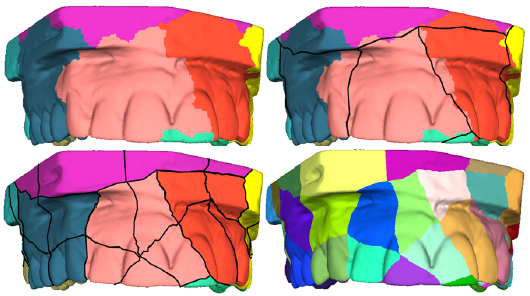 |
-
- Seamless
Texture Atlases
- B.
Purnomo, J. D. Cohen, and S. Kumar
- Eurographics/ACM
SIGGRAPH Symposium on
Geometry Processing 2004
- Abstract:
Texture atlas
parameterization provides an effective way to map a variety of color
and data attributes from 2D texture domains onto polygonal surface
meshes. However, the individual charts
of such atlases are typically plagued by noticeable seams. We describe
a new type of atlas which is seamless
by construction. Our seamless atlas comprises all quadrilateral charts,
and permits seamless texturing, as
well as per-fragment down-sampling on rendering hardware and polygon
simplification. We demonstrate the use of
this atlas for capturing appearance attributes and producing seamless
renderings.
|
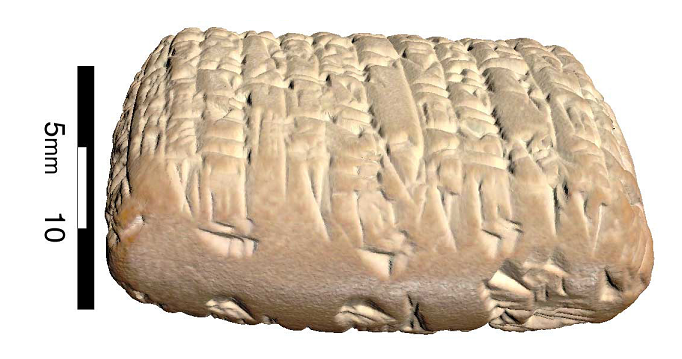 |
-
- iClay:
Digitizing Cuneiform
- J.
D. Cohen, D. Snyder, D. Duncan, J.
Cooper, S. Kumar, D. Hahn, Y. Chen, B. Purnomo, and J. Graettinger
- Virtual
Reality, Archaeology and
Cultural Heritage (VAST 2004)
- Abstract: Advances
in
digital technology for the graphic and textual representation of
manuscripts have not, until recently, been applied to the worldʼs
oldest manuscripts, cuneiform tablets. This is due in large part both
to the three-dimensional nature of cuneiform tablets and to the
complexity of the cuneiform script system. The Digital Hammurabi
Project and the Initiative for Cuneiform Encoding announce success in
encoding Sumero-Akkadian cuneiform in Unicode while also demonstrating
advances in 3D scanning and visualization of cuneiform tablets,
showcased by iClay, a cross-platform, Internet-deployable, Java applet
that allows for the viewing and manipulation of 2D+ images of cuneiform
tablets.
-
|
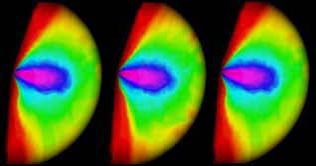 |
-
- On the
Visualization of Time-Varying Structured Grids Using a 3D Warp Texture
- Y.
Chen, J. D. Cohen, and S. Kumar
- Poster
and Interactive Demos at IEEE Visualization 2004, Best
Poster Award
- Abstract: We
present a
novel scheme to interactively visualize time-varying scalar fields
defined on a structured grid. The underlying approach is to maximize
the use of current graphics hardware by using 3D texture mapping. This
approach commonly suffers from an expensive voxelization of each
time-step as well as from large size of the voxel array approximating
each step.
- Hence,
in our scheme, instead of explicitly voxelizing each scalar field, we
directly store each time-step as a three dimensional texture in its
native form. We create the function that warps a voxel grid into the
given structured grid. At rendering time, we reconstruct the function
at each pixel using hardware-based trilinear interpolation. The
resulting coordinates allow us to compute the scalar value at this
pixel using a second texture lookup. For fixed grids, the
function
remains constant across time-steps and only the scalar field table
needs to be re-loaded as a texture. Our new approach achieves excellent
performance with relatively low texture memory requirements and low
approximation error.
-
|
|
-
- Digital
Preservation of Ancient Cuneiform Tablets Using 3D Scanning
- S.
Kumar, D. Snyder, D. Dunca, J. D.
Cohen, and J. Cooper
- Proceedings
of IEEE Fourth
International Conference on 3-D Digital Imaging and Modeling, 2003
-
|
|
-
- Budget
Based Sampling of Parametric Surface Patches
- J.
Chhugani, and S. Kumar
- ACM
3D Interactive Graphics 2003
-
|
|
-
- Successive
Mapping: An Approach to Polygonal Mesh Simplification with Guaranteed
Error Bounds
- J.
D. Cohen, D. Manocha, and M. Olano
- International
Journal of Computational
Geometry and Applications. 13 (1). February 2003. pp. 61-94.
-
|
|
-
- Perceptually
Guided Simplification of Lit, Textured Meshes
- N.
Williams, D. Luebke, J. D. Cohen, M.
Kelly, and B. Schubert
- Proceedings
of 2003 ACM Symposium on
Interactive 3D Graphics. pp. 113-121. (selected for cover image)
-
|
|
-
- GLOD: A
Geometric Level of Detail System at the OpenGL API Level
- J.
D. Cohen, N. Duca, D. Luebke, and B.
Schubert
- IEEE
Visualization 2003,
Seattle, WA (2003), Best
poster award.
- [Project
Page]
-
|
|
-
- ISOSLIDER:
A System for Interactive Exploration of IsoSurfaces
- J.
Chhugani, S. Vishwanath, J. D.
Cohen, and S. Kumar
- VisSym
2003. pp. 259--266.
-
|
|
-
- Level of
Detail for 3D Graphics
- D.
Luebke, M. Reddy, J. D. Cohen, A.
Varshney, B. Watson, R. Huebner
- Morgan
Kaufmann Publishing 2002. ISBN
1-55860-838-9. 432 pages
- [ Amazon
] [ Barnes
& Noble ].
-
|
|
-
- Interactive
Visualization of Unstructured Grids Using Hierarchical 3D Textures
- J.
Leven, J. Corso, J. D. Cohen, and S.
Kumar
- Proceedings
of IEEE/SIGGRAPH
Symposium on Volume Visualization and Graphics 2002. pp. 37-44
- [ Video
]
-
|
|
-
- Hybrid
Simplification: Combining Multi-resolution Polygon and Point Rendering
- J.
D. Cohen, D. G. Aliaga, and W. Zhang
- Proceedings
of IEEE Visualiztion 2001.
pp. 37-44 and 539
- [ Video
]
-
|
|
-
- View-Dependent
Adaptive Tessellation of Spline Surfaces\
- J.
Chhugani, and S. Kumar
- ACM
Symposium on 3D Interactive
Graphics, 2001. pp 59-62
-
|
|
-
- Efficient
Perspective-Accurate Silhouette Computation
- M.
Pop, W. Huang, G. Barequet, C. A.
Duncan, M. T. Goodrich, and S. Kumar
- ACM
Computational Geometry, 2001. pp
60-68
-
|
|